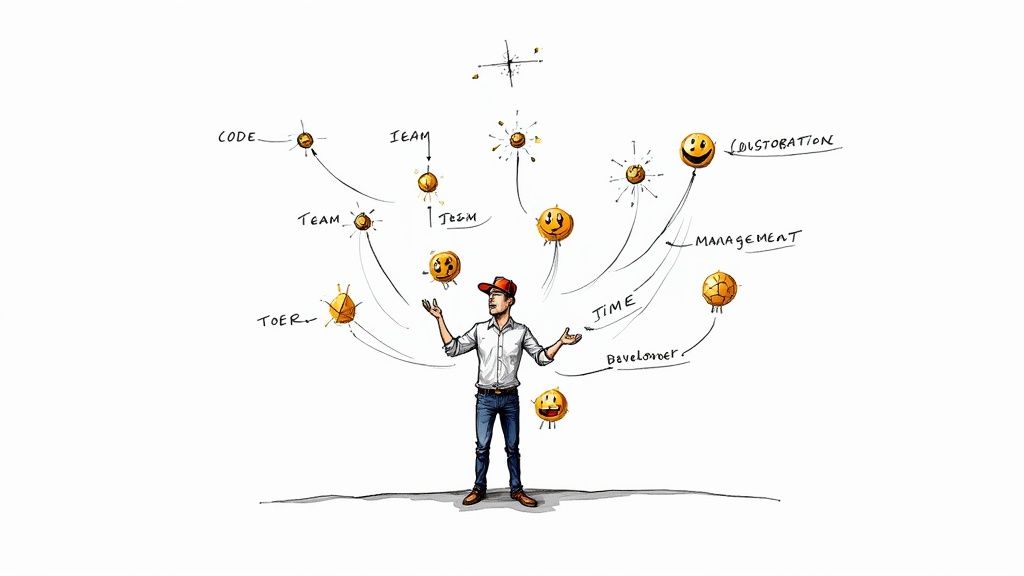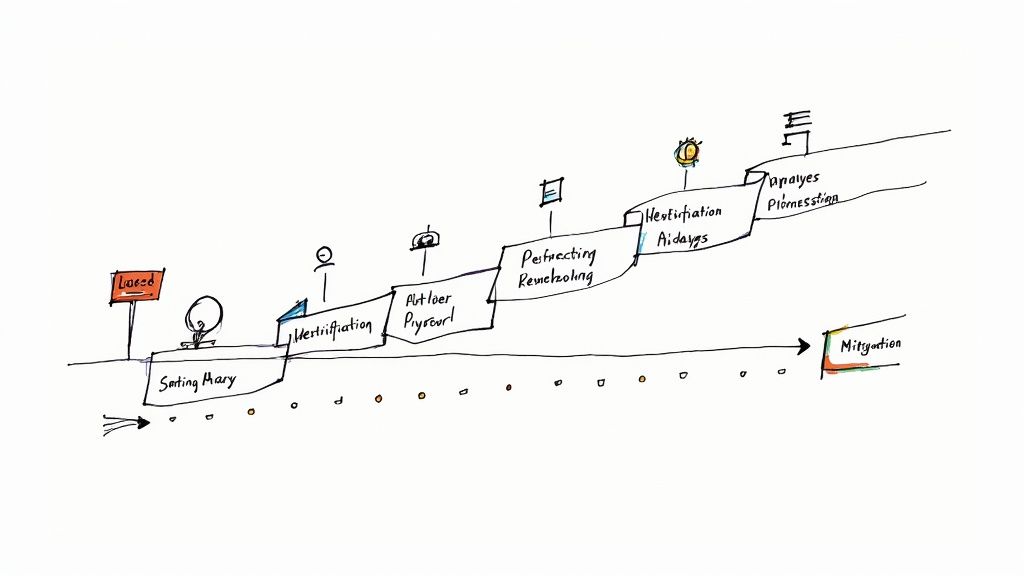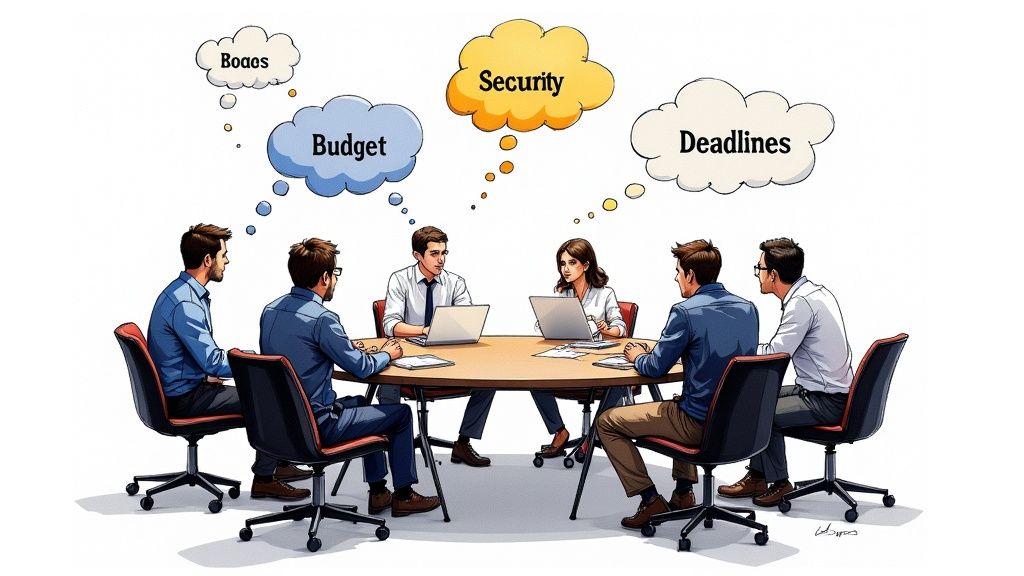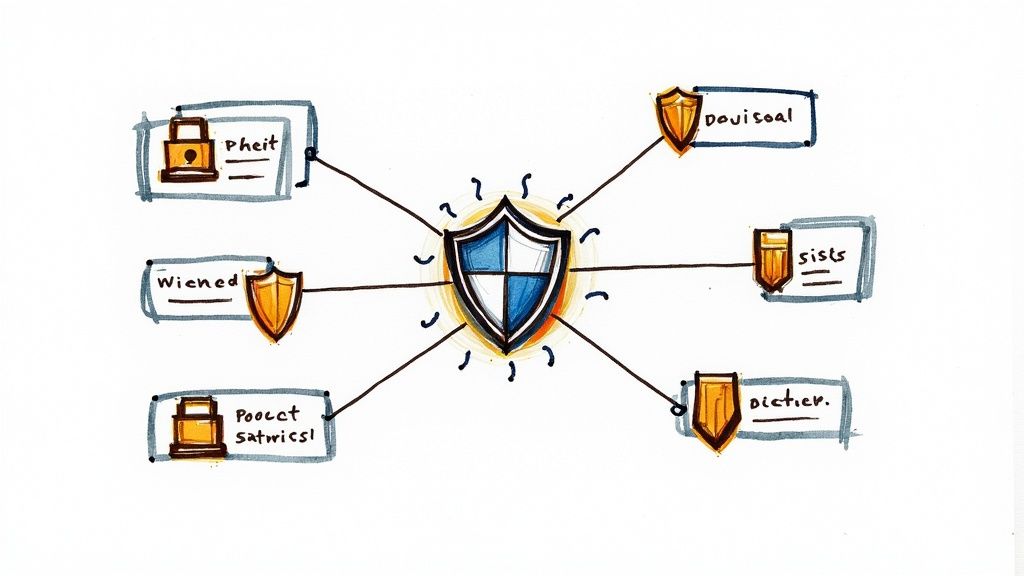Software Development Risk Management: A Field Guide to Project Success

Why Traditional Risk Management Isn't Working Anymore

Most software teams still rely on basic tools like spreadsheets and occasional risk reviews, but this old-school approach is falling short. The rapid pace of modern development means problems can emerge and cause damage long before they're spotted in quarterly reviews. This explains why 62% of organizations face major failures even when following standard risk protocols - their methods simply can't keep up with how quickly things change in software projects today.
The Problem With Static Approaches
Think of using outdated risk management like trying to navigate a busy city with a map from five years ago. While the map shows the main roads, it misses all the recent changes - new construction, closed streets, and altered traffic patterns. Similarly, reviewing risks every few months means missing how different problems connect and influence each other in complex software projects. Just as an old map leads to wrong turns and delays, rigid risk tracking leaves teams unable to spot and handle real issues as they come up.
The Need for Dynamic Risk Management
Forward-thinking teams are moving away from basic checklists toward what you might call "risk intelligence" systems. These approaches use constant monitoring, quick feedback, and early warning signs to catch problems before they grow. For instance, running automated tests and code analysis helps flag potential issues right away instead of discovering them weeks later. This helps teams get ahead of risks rather than always playing catch-up. Making risk management an ongoing part of development, not just a periodic task, leads to much better results.
The Impact of Improved Risk Management
Getting risk management right brings clear benefits: fewer delays, lower costs, and better software quality. But good risk management does more than prevent problems - it gives teams the confidence to try new things. When you have solid systems to identify and handle potential issues, you can explore fresh approaches knowing you'll catch problems early. This creates an environment where calculated risks lead to creative solutions. The result? Teams can take on complex challenges while still delivering successful projects. You might be interested in: Our sitemap for more related posts.
Building Your Risk Intelligence System

Effective risk management requires moving beyond static reports to build a system that delivers real intelligence. The key is converting raw project data into clear, actionable insights that teams can use. Rather than producing lengthy reports that go unread, successful organizations create focused systems that highlight genuine threats while filtering out background noise. This approach helps teams respond quickly to emerging issues and address potential problems before they escalate.
From Data to Insights: The Foundation of Risk Intelligence
Building risk intelligence starts with thorough data collection across key metrics. Teams need to track essential indicators like code complexity, test coverage, bug frequency, and development velocity. These metrics reveal important patterns - for instance, when bug reports spike while test coverage drops, it often signals emerging quality issues. External factors matter too - keeping tabs on market shifts and new regulations provides crucial context. This diverse data forms the basis for generating useful insights.
Creating an Early Warning System
Once you have good data flowing, the next step is building alerts that catch problems early. This means setting smart thresholds and automated notifications. For example, your system might alert specific team members when critical bugs pass a certain number. The key is making alerts targeted and meaningful - too many notifications become noise that teams ignore. Focus on flagging issues that truly need attention and prompt action.
Leveraging Historical Data for Predictive Analysis
Looking at past project data helps teams spot patterns and get ahead of future risks. Instead of just reacting to problems as they come up, teams can identify likely issues before they happen. Consider a team that notices tight deadlines consistently leading to technical debt in their projects. With this insight, they can build in realistic timelines and set aside resources to handle technical debt early, preventing it from piling up.
Building a Risk Response Framework
An effective risk system needs clear plans for handling different types of issues. This means defining specific steps to take when problems arise. Take security vulnerabilities - a good response plan spells out exactly who reviews the code, when to run security tests, and how to communicate with users and stakeholders. Having these processes ready speeds up response times and helps teams handle unexpected challenges consistently. This shifts risk management from reactive to proactive by combining real-time monitoring, historical learning, and prepared response plans.
Making Risk Management Work in Agile Teams

Managing risk effectively doesn't have to slow down Agile teams. In fact, when done right, risk management can speed up development by catching issues early. As software projects grow more complex, teams that handle risks well tend to deliver more consistently and with fewer surprises.
Integrating Risk Discussions Into Agile Ceremonies
Rather than treating risk management as a separate process, successful teams weave it naturally into their existing Agile meetings and workflows:
- Sprint Planning: This is when teams spot potential issues with upcoming work. For example, if you're planning to integrate a new external API, you might discuss risks like rate limits or data format mismatches. By identifying these concerns early, teams can plan ahead and avoid getting stuck.
- Daily Stand-Ups: While these meetings focus on progress updates, they're also perfect for flagging new problems. A developer might mention struggling with an unexpected technical limitation, giving the team a chance to help before it becomes a bigger issue.
- Sprint Retrospectives: These meetings help teams learn from experience. What risks actually caused problems? Which ones didn't matter? What worked well in handling them? Teams use these insights to get better at spotting and managing risks in future sprints.
Maintaining Risk Awareness in a Fast-Paced Environment
Working in Agile means things move quickly. Staying on top of risks requires consistent attention and the right approach:
- Visualizing Risks: Using a simple board to track known risks keeps them visible to everyone. When risks are out in the open, team members are more likely to tackle them proactively.
- Regular Risk Reviews: While Agile emphasizes ongoing communication, it helps to set aside specific time to review risks. This could be a quick check during each sprint or a deeper review between releases.
- Integrating Risk Management Tools: Tools like Mergify can help prevent common problems through automation. For instance, automated merge queues catch integration issues early, while code quality checks spot potential problems before they reach production.
By making risk management a natural part of daily work, Agile teams can move faster with more confidence. Instead of seeing it as extra overhead, teams find that good risk management leads to smoother sprints, better code quality, and fewer emergencies. This practical approach helps deliver working software more reliably, which is what Agile is all about.
Using AI to Prevent Software Development Risks

A solid risk intelligence system sets the stage for bringing AI into the software development process. Instead of just looking at past data and relying on manual analysis, teams can now use AI to spot and address risks before they become problems. This new approach helps catch issues earlier and more reliably than traditional methods alone.
Smart Code Analysis and Bug Finding
AI truly shines when it comes to reviewing code automatically. Tools powered by AI can scan entire codebases to find potential bugs, security issues, and problematic code patterns that humans might overlook. For example, these tools can spot signs of memory leaks or buffer overflows early on, preventing serious problems before code goes live. The tools get better over time too - they learn from previous issues to catch similar problems in the future, helping build more stable and secure software.
Seeing Problems Before They Happen
AI excels at finding patterns and making educated guesses about what might happen next based on available information. For software development teams, this means AI can look at project history - including bug reports, code changes, and test results - to predict potential problems. If AI notices that growing code complexity might delay delivery, teams can adjust their plans or add more resources before falling behind schedule.
Combining AI Smarts with Human Judgment
While AI brings powerful capabilities to the table, it works best as a helper rather than a replacement for human expertise. Smart organizations know that the best results come from using AI alongside human oversight. AI provides valuable data and predictions, but human judgment remains essential for understanding those insights in context and making good decisions. This teamwork between AI and humans leads to better risk management in software development. You might be interested in: Checking out our sitemap of pages for related articles.
Understanding AI's Limits in Risk Management
While AI offers great benefits, it's important to be realistic about what it can and can't do. Since AI learns from historical data, it may struggle with new types of risks or rapid changes. AI models can also inherit biases from their training data. This means teams need to carefully review AI-generated insights rather than accepting them blindly. Regular monitoring, human verification, and updating AI models help address these limitations and ensure AI contributes effectively to software development risk management. By understanding both what AI does well and where it falls short, teams can use this technology wisely to achieve better project results.
Creating Risk Response Plans That Actually Work
Many software teams struggle to create risk response plans that deliver real value when problems strike. While they may spend hours drafting detailed plans, these documents often collect dust instead of providing practical guidance during critical moments. Let's explore how successful teams develop and implement response strategies that truly protect their projects.
Prioritizing Risks Based on Real Impact
The foundation of effective risk management is accurately assessing each risk's real-world consequences rather than relying on theoretical frameworks. Teams need to analyze potential fallout in concrete terms - for example, a seemingly minor security flaw could have major repercussions if it affects core functionality used by thousands of customers. By focusing on tangible impacts rather than abstract risk scores, teams can direct their efforts toward addressing the most significant threats to project success.
Building Actionable Contingency Plans
Think of a good contingency plan like a well-rehearsed fire drill - everyone knows exactly what steps to take when problems arise. The plan should use clear language, outline specific actions, and define who is responsible for what. Regular reviews and updates ensure the plan stays current as project conditions evolve. Teams can then respond quickly and effectively when issues emerge, keeping work on track with minimal disruption. For more collaborative development approaches, check out our guide on author insights at Mergify.
Learning From Past Experiences: The Power of Post-Incident Reviews
After dealing with a risk event, whether successfully or not, thorough post-incident analysis is essential. These reviews help teams understand the root causes and prevent similar issues in the future. For instance, if project delays stemmed from problems with a third-party component, the review might point to needed improvements in vendor management or backup solutions. The key insights can then strengthen existing response plans and inform smarter risk management going forward.
From Reactive to Proactive: Implementing Early Warning Systems
Moving from reactive to proactive risk management is crucial for building reliable software. Teams should put systems in place to catch potential problems early through practices like automated testing, continuous integration, and regular code reviews. Beyond just finding current issues, these approaches provide data to help anticipate and prevent future risks. Clear communication channels and escalation procedures ensure quick identification and handling of emerging concerns. By embracing these strategies, development teams can create dynamic, practical risk response plans that truly safeguard their projects from disruption.
Measuring What Matters in Risk Management
Creating an effective software development risk management strategy requires more than just spotting and fixing potential issues. Success depends on accurately tracking progress and using that information to make improvements. While many teams only look at basic metrics like the number of identified risks, the most successful organizations measure specific outcomes that directly impact project success, like meeting deadlines and managing costs.
Key Metrics for Software Development Risk Management
The right metrics reveal not just what activities are happening, but how well those efforts are working to reduce project risks. Here are the essential metrics to track:
- Risk Burn-Down Rate: Much like tracking bug fixes, this shows how quickly the team resolves identified risks over time. A steady downward trend means the team is successfully reducing project risks. Visualizing this progress helps keep everyone focused on risk reduction goals.
- Cost of Risk: This tracks the actual money spent dealing with problems when risks become reality. For example, if a security issue leads to a breach, you'd add up all related expenses like legal fees, customer compensation, and fixing affected systems. Having clear cost numbers helps justify investing in prevention.
- Risk Response Time: Looking at how fast teams address new risks helps spot bottlenecks. Quick responses usually mean less severe impacts. This encourages teams to jump on issues right away rather than letting them linger.
- Number of Risks Identified Proactively vs. Reactively: This shows whether teams are catching potential problems early or just putting out fires. Finding more risks proactively indicates a well-functioning risk management process.
Conducting Effective Risk Management Audits
Regular check-ups ensure your risk management process works as planned and produces real results. These reviews should generate specific steps for improvement:
- Focus on Process, Not Just Documentation: While having written procedures matters, what's more important is seeing how teams actually handle risks day-to-day. Watch how people work together, review risk tracking records, and talk to team members about their experiences. It's like checking if a restaurant's kitchen staff actually follows food safety rules, not just confirming they have a manual.
- Use Data to Drive Improvement: Look at your metrics to find weak spots. For instance, if risks are piling up without being addressed, you might need more resources or clearer ownership. Let the numbers guide where you focus improvement efforts.
- Involve the Team in the Audit Process: Get input from people doing the work about what's challenging and what could work better. This creates buy-in and surfaces practical solutions based on real experience.
The Value of Feedback and Continuous Refinement
Good risk management constantly evolves based on what works and what doesn't. Review completed projects to spot patterns and refine your approach. Use team retrospectives to discuss successes, failures, and ideas for improvement. This ongoing feedback helps you adapt risk management to each project's specific needs while getting better over time. By focusing on meaningful measurements, thorough reviews, and steady improvement, teams can use risk management effectively to deliver quality work on schedule and within budget.
Make your development process smoother and catch risks early with Mergify. Learn more about how Mergify can enhance your team's risk management strategy.





